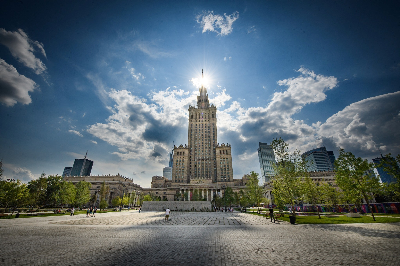
© Facebook Pałac Kultury i Nauki Warszawa
У липні 2025 року, відзначається 70-річчя відкриття Pałac Kultury i Nauki (PKiN) — палацу культури та науки у Варшаві. Будівлю було споруджено як так званий «дар радянського народу» Польщі (відкриття — 21 липня 1955 року), і довгий час вона була другою найвищою спорудою в Європі — поступаючись лише головному корпусу Московського університету ім. Ломоносова. Освітлений шпиль підняв загальну висоту до 237 метрів, включаючи антену. Автор проєкту — радянський архітектор Лев Руднєв — зводив будівлю у стилі радянського монументалізму, натхненого американськими арт-деко хмарочосами і варшавською архітектурною традицією (Ренесанс, модернізм). Понад 3 500 радянських і 4 000 польських робітників взяли участь у спорудженні, яке завершили менш ніж за чотири роки, лишивши по собі 16 жертв серед робітників. PKiN сьогодні — культурний центр Варшави: тут розташовані чотири театри (Dramatyczny, Studio), великі конференц-зали, концерти, кінотеатр, музей, кінотеатр, великий басейн, власна вивіска університету Collegium Civitas. На 30-му поверсі розташована відкрита тераса з панорамою Варшави — одна з найпопулярніших туристичних атракцій столиці. Від моменту зведення варшав’яни асоціюють палац з радянським домінуванням. У народній пам’яті його називали «Пекіном» (від абревіатури PKiN), «Паяцем», або навіть «ракетою Сталіна» — іронічні прізвиська підтверджують подвійне ставлення до пам’ятки: символ чи ганьба комуністичної епохи? Попри заклики знесення (між іншими, від Радослава Сікорського у 2007 році), 77 % поляків не підтримують руйнування палацу. Навіть серед консерваторів лише 12 % виступають за демонтаж цього «соціалістичного монументу».
In July 2025, Warsaw celebrates the 70th anniversary of the opening of the Pałac Kultury i Nauki (Palace of Culture and Science, PKiN). The building was erected as a so-called "gift from the Soviet people" to Poland and was officially opened on July 21, 1955. For many years, it was the second tallest building in Europe — second only to the main building of Moscow State University. Its illuminated spire brings the total height to 237 meters, including the antenna. The project was designed by Soviet architect Lev Rudnev in the style of Soviet monumentalism, influenced by American Art Deco skyscrapers as well as Warsaw’s own architectural traditions, such as Renaissance and modernism. Over 3,500 Soviet and 4,000 Polish workers were involved in the construction, which was completed in less than four years, though it claimed the lives of 16 workers. Today, PKiN serves as a cultural hub in the heart of Warsaw. It houses four theaters (including Dramatyczny and Studio), large conference halls, concert venues, a cinema, a museum, a large indoor swimming pool, and is home to Collegium Civitas university. The 30th floor features an open-air viewing terrace that offers a panoramic view of the city — one of Warsaw’s most popular tourist attractions. Since its construction, the palace has been closely associated with Soviet dominance. Locals have nicknamed it “Beijing” (a play on the PKiN acronym), “the Clown,” or even “Stalin’s Rocket” — ironic names that reflect the complex public sentiment surrounding the building: a symbol of pride or a relic of communist shame? Despite recurring calls for its demolition — including one from Radosław Sikorski in 2007 — 77% of Poles oppose tearing down the structure. Even among conservatives, only 12% support dismantling what many now view as a “socialist monument.”
1759